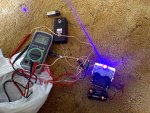I recently purchased a $36 (w/shipping) BlueRay PS3 400A lens assembly from PSXBOY.COM
just barely got it mounted it in a Aixiz module and had it running smooth... but
another one is on it's way because I burned this one out by switching my DMM meter OFF while reading the current, which disconnected the laser diode from the driver circuit I had built, and then I mistakingly switched the DMM back ON, which caused a voltage spike from the CAPacitor, burning the diode. Then I burned the rest of the diode out for fun ha. The red and IR aren't that powerful anyways and I have plenty of them. it was a good learning experience but I sure hope I don't f#&*K that shit up again because 407nm is COOL
but anyways below is a picture of my setup when it was operational, you can see 57.9 mA (ignore the negative sign) going into the diode, and I am running the popular DDR circuit mentioned here in the forums off a 9v battery partially diminished to ~8v.
I would like to know a couple of things if you have the time & knowledge to answer them:
Why use a voltage regulator (the 317 component)? does it really matter what voltage the diode is connected to, as long as it's not enough to arc? is 9v going to be dimmer than 10v at the same current in a blueray? someone told me the diode draws the voltage it requires, so if I connect a bunch of batteries in series, is that going to work, or is that putting too much current into the circuit?
Is a heat sink necessary for the blueray?
how exactly does a KTP crystal work, what does it do entirely? where can I get one or two?
does the output current from the photodiode in the blueray have a linear (direct) relationship with the optical output of the violet diode? is this an easy way to see if the diode is losing brightness?
Thanks and happy harvesting
just barely got it mounted it in a Aixiz module and had it running smooth... but
another one is on it's way because I burned this one out by switching my DMM meter OFF while reading the current, which disconnected the laser diode from the driver circuit I had built, and then I mistakingly switched the DMM back ON, which caused a voltage spike from the CAPacitor, burning the diode. Then I burned the rest of the diode out for fun ha. The red and IR aren't that powerful anyways and I have plenty of them. it was a good learning experience but I sure hope I don't f#&*K that shit up again because 407nm is COOL
but anyways below is a picture of my setup when it was operational, you can see 57.9 mA (ignore the negative sign) going into the diode, and I am running the popular DDR circuit mentioned here in the forums off a 9v battery partially diminished to ~8v.
I would like to know a couple of things if you have the time & knowledge to answer them:
Why use a voltage regulator (the 317 component)? does it really matter what voltage the diode is connected to, as long as it's not enough to arc? is 9v going to be dimmer than 10v at the same current in a blueray? someone told me the diode draws the voltage it requires, so if I connect a bunch of batteries in series, is that going to work, or is that putting too much current into the circuit?
Is a heat sink necessary for the blueray?
how exactly does a KTP crystal work, what does it do entirely? where can I get one or two?
does the output current from the photodiode in the blueray have a linear (direct) relationship with the optical output of the violet diode? is this an easy way to see if the diode is losing brightness?
Thanks and happy harvesting






